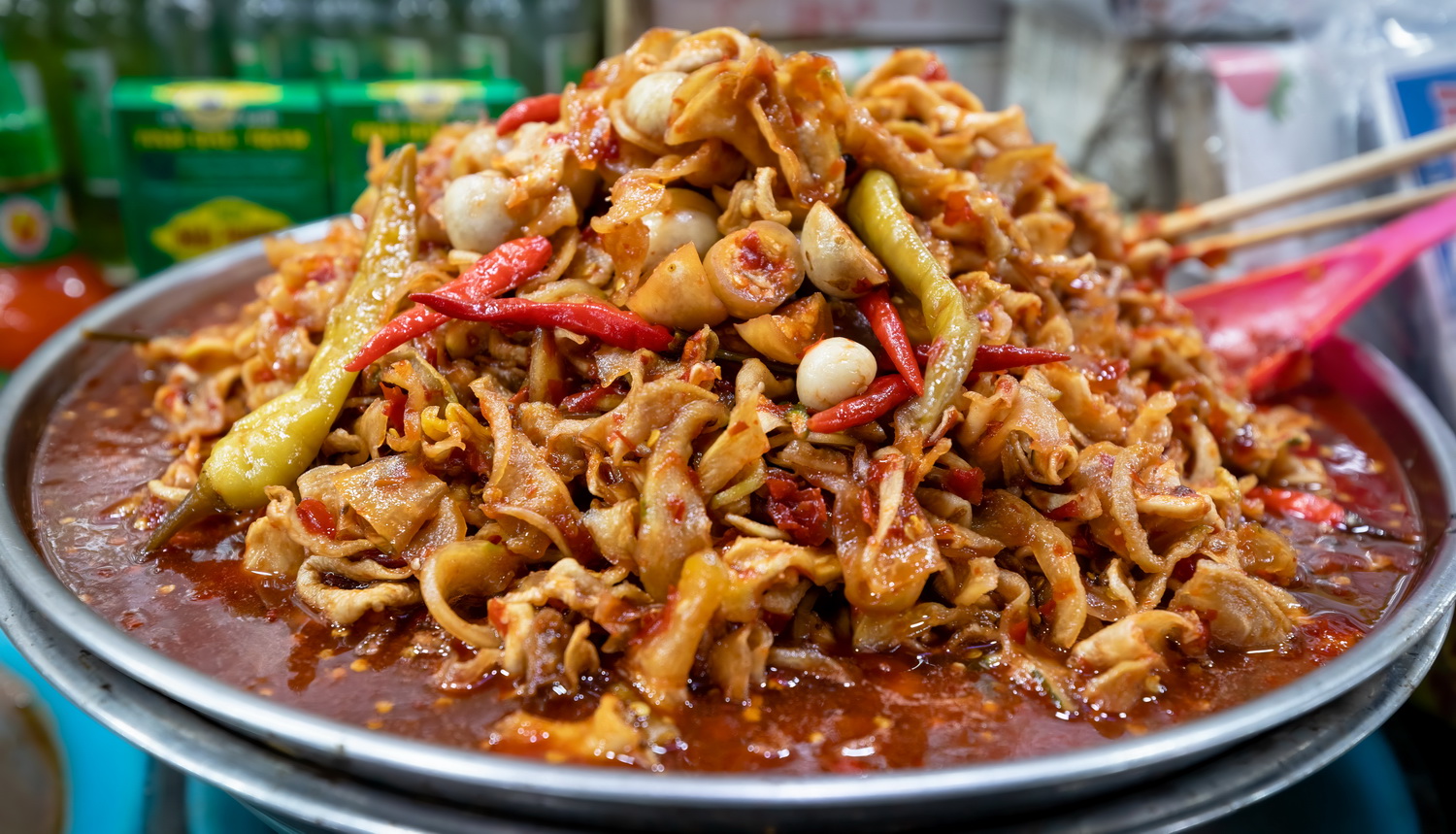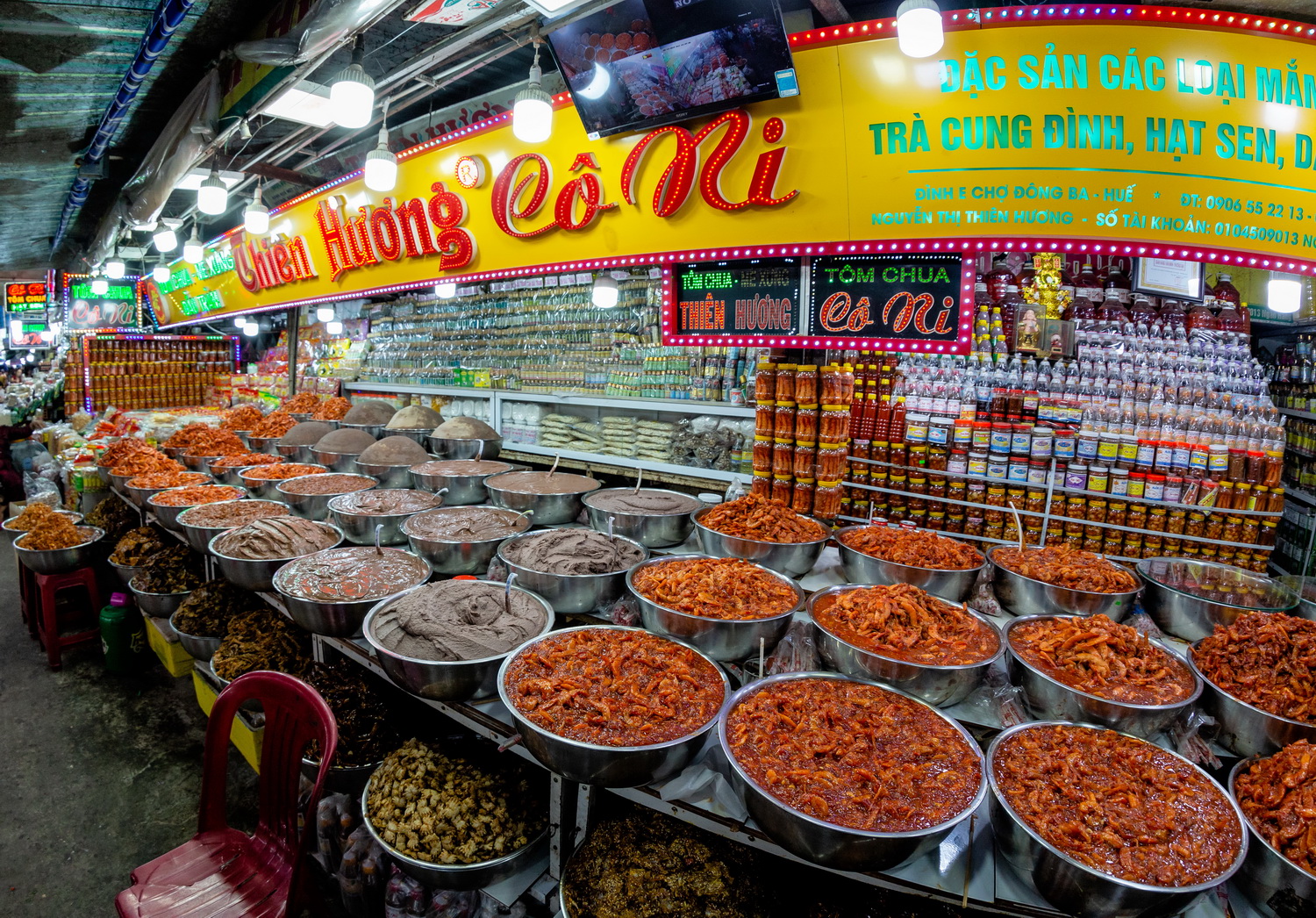.jpg)
Different kinds of mam (fermented fish) and tom chua (sour shrimp) at Dong Ba Market
As a representative of Vietnam, I introduced the fermented food of Hue to the Korean public with the speech: “Fermented Foods in Traditional Cuisine of Hue: Value, Heritage and Continuity in Contemporary Cuisine in Hue.”
Hue has all typical forms of topography of Central Vietnam such as sea, lagoon, plain, highland and forest. The five ecosystems in correspondence to those forms of terrain are: coastal ecosystem, lagoon ecosystem, agricultural ecosystem, garden ecosystem, and forest ecosystem. It is the diversity of ecosystem that creates a rich source of ingredients, both animal-based and plant-based, for food for Hue people.

Fermented fish with papaya
With those ingredients and their deft hands, Hue people create a diverse and unique cuisine. Besides, the hot and humid weather with lots of rain and sunlight is an advantage for the fermentation of food. Processing fermented food into various delicious and nutritious dishes and drinks has thus become a tradition in Hue cuisine.
Hue people have various ways to ferment food, depending on available ingredients and their objectives. They are:
- chuop: chuop means marinating fish with salt in a certain proportion in a long period of time to obtain fermented fish and fish sauce;
- u: u means keeping peas in pots with tight covers. The heat from the sun turns them into various kinds of tuong. The same way is done with soy beans to obtain soy sauce or with tofu to have chao or with sticky rice and natural yeast to obtain com ruou;- uop: uop means marinating fish or meat with salt or fish sauce and other spices in a short period of time before grilling or cooking with the aim of giving the food the sour taste and better flavor;
- ngam: ngam means soaking vegetables, roots or fruits in salt water or vinegar in a short period of time to obtain pickles to be eaten with the main dish of meat or fish.
- dam: dam mean soaking fruits or seeds with sugar or salt in a long period of time to obtain beverages such as peach drink, berry wine, apple cider, salted lime, etc.
- thinh: thinh means marinating fish or meat with fried cereal powders to obtain mam thinh, nem thinh, etc.
Those fermentation methods have been skillfully employed by Hue people for ages. Together with other elements such as climate, weather, time, ingredients and aims, they create a diverse system of fermented food in Hue cuisine.

Fermented food is present in both popular and luxurious dishes, in dry or soup dishes, in non-veg dishes as well as in vegetarian dishes; and in salty and in sweet dishes. They can be classified into various groups such as main dish, side dish, fermented food as main ingredients or as spices, and even in beverages.
In the fermented food of Hue people, mam and fish sauce are the best achievements. They can be found everywhere in Vietnam, but no one can process them into various delicious dishes better than Hue people.
Mam has a special position in Hue cuisine. There are various kinds of mam and different ways of cooking it. There is mam made from rare and precious ingredients such as siganus, mullet, crab-roe, mackerel, tuna, etc. Hue people turn mam from a popular dish to delicacies served to kings and mandarins in the old days while people today consider them luxurious specialities of Hue.
Besides, there are popular mam made from available cheap ingredients with simple methods. They are served in everyday meals of the populace such as mam thinh ca chuon, mam moi, mam nem, mam ro, mam muc, mam so, mam hau, mam ruoc, tom chua, tep chua, etc.
Fish sauce is used by Hue people as a special spice which is indispensable when cooking Hue dishes, both popular and luxurious. From fish sauce, Hue people can make about 30 different sauces with various tastes: salty, sweet, sour, hot, etc., to be eaten with different dishes. In Hue cuisine, each dish is accompanied by a different kind of sauce made from basic fish sauce.
Today different kinds of fermented food such as mam and pickles and fruit ciders, etc., are mass produced by Hue people. Many popular dishes processed from fermented food have been upgraded to become specialties which can satisfy even picky diners.
In the discussion section of the conference, I was asked two exciting questions: “At the moment, the youth in Korea and many countries in ASEAN tend to say no to traditional fermented food. How about the youth in Hue?” and “What will Hue people do to maintain and develop their fermented food, not only as everyday food but also potential valuable products of the food industry?”
From my observation, the first question does not apply to the youth in Hue. While the youth in developed countries like fast food, fermented food is present in everyday meals of Hue people and in many street foods that Hue youth like very much such as bun mam, bun nem, bun thit nuong, nem chua, tre, etc.
As for the second question, I think it is a good suggestion for the authorities, entrepreneurs and food processors in Hue in planning production, development and promotion of the fermented food in Hue in the future.
“Using fermented food is now a tendency in many developed countries in the world. The fermented food industry also brings back many benefits compared with producing other food because fermented food has higher commercial value and its transport and protection fees are lower than fresh food,” concluded Prof. Shin Dong Hwa in his excellent speech about the fermented food in Korea.
Story: Nhat Quang, Photos: Nguyen Phong